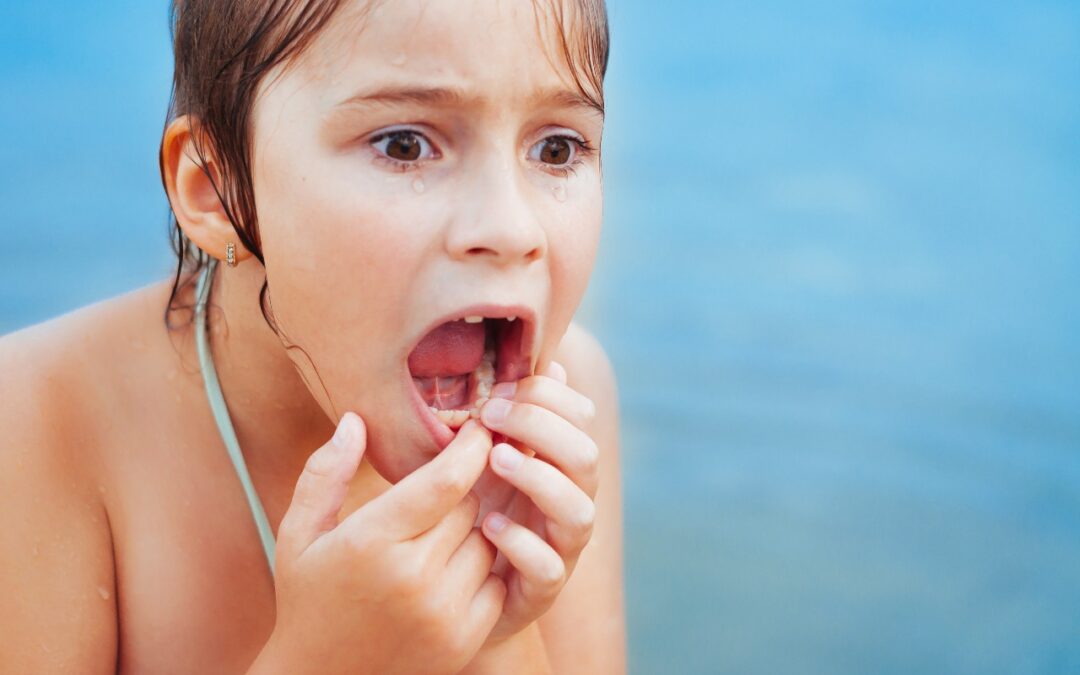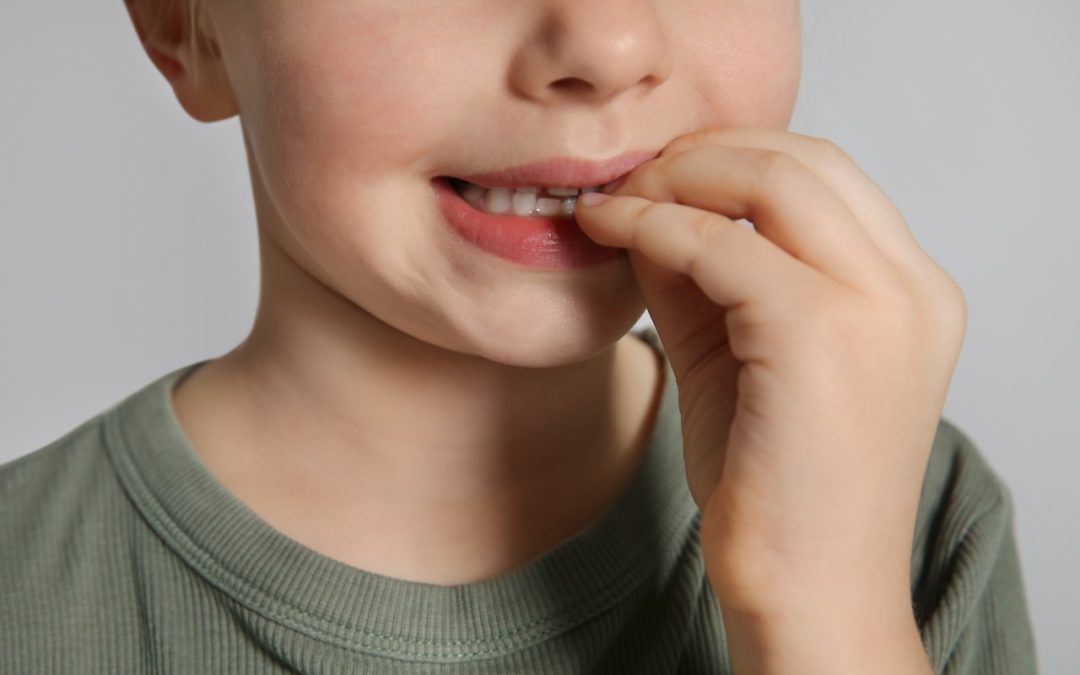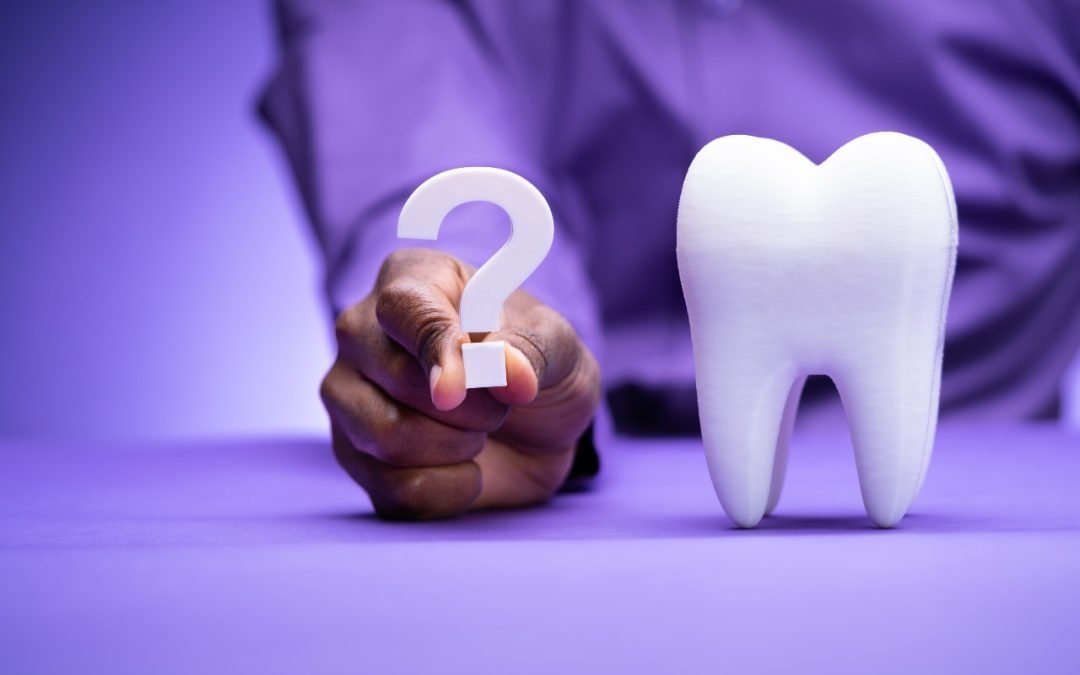


Why is My Child’s Tooth Grey? Grey Teeth Explained
While the majority of our population is in fact, not dental experts, society actually as a whole has a few very firm (and correct) understandings and expectations when it comes to the topic of healthy teeth.
We expect our babies to grow the first few adorable little whites within the first year. Most homes generally have a routine to brush teeth in the mornings and again at night before bed. We teach our children to put their lost teeth under their pillow for the tooth fairy, and we associate healthy smiles to the general color category of white. So, what does it mean then, when one of your kids’ pearlies is actually a grey color?
A grey tooth is what we call a necrotic tooth or pulp necrosis. This means that the pulp of the tooth has suffered damage to its blood supply. Without proper blood supply, the tissue begins to die, thereby changing the color of the tooth from white to grey.
Why is My Child’s Tooth Grey?
The potential causes of a grey tooth include the following:
- Dental trauma – this is the most likely cause of a necrotic tooth in children. One of the reasons we strongly advise parents to invest in mouth guards for kids who play sports of any kind is because the use of mouth guards can actually reduce the chances of a dental trauma injury by 73%-83%. Nevertheless, even with the use of mouth guards while engaged in sports activities dental trauma injuries can occur. An accidental elbow to the face, or a head first tumble for your walking toddler. These injuries can occur even with the best of safe guards in place. If your child has suffered a dental injury such as a chipped tooth or a tooth has been knocked loose or all the way out, follow these steps and give us a call immediately. Quick reactions can save the tooth.
- Severe and untreated tooth decay – this cause is less likely if you’re keeping your kids to the recommended biannual cleaning and checkup schedule in addition to encouraging healthy dental hygiene routines at home.
- Gum disease – another cause avoidable with healthy dental hygiene at home and routine checkups and cleanings at your local pediatric dentist.
Can a Grey Tooth Be Saved?
Actually, a grey tooth can be saved if action is taken quickly enough. When the whole of the tooth is mostly intact in spite of the dead or dying pulp tissue within, measures can be taken to save the tooth itself. For this we may perform a pediatric pulpotomy or a root canal.
This means we must first create a hole within the enamel to get inside the tooth to remove the infected or decaying pulp from the inside of the tooth. Next a healing medicine is applied to soothe the nerves and treat any bacteria attempting to grow (which can spread to the root and cause an abscess if untreated). Once that part of the treatment is completed, we reseal the entry and create a cap to cover the tooth. If the tooth in question is a baby tooth (primary tooth) we may opt to cover the entry with a composite filling instead of a cap. A composite filling is a more economic route, and only appropriate in the case of a primary tooth because the tooth’s lifespan is only a few years as opposed to if it were a permanent tooth in question.
Does a Dead Baby Tooth Need to Be Pulled?
In general, we avoid tooth extractions whenever possible. The primary teeth, serve as place holders for their permanent teeth and our bodies generally allow primary teeth to loosen and fall out naturally in accordance for the timing of the eruption of the permanent teeth. Additionally, primary teeth serve to help our children chew and eat foods properly and develop proper speech patterns.
Nevertheless, if your child has a necrotic tooth that is causing severe pain, an infection in the gums or spreading to other teeth, a pediatric pulpotomy may not be appropriate. In these rare circumstances, we may need to simply extract the tooth. For this to be necessary your child would likely be experiencing severe tooth pain, therefore we urge parents to listen to their children when they complain of tooth pain. Don’t wait for it to become severe before scheduling an appointment for a consult.
What if the Teeth Have Grey Spots?
If the tooth or teeth are not wholly grey but instead have grey or black spots or streaks, that doesn’t necessarily mean necrosis is to blame.
These grey colored spots may be indicative of too much iron in their diet. Iron supplements, fortified cereals, or iron-rich water may be to blame. When iron is the culprit, assist your child with tooth brushing for a time and they will disappear.
Grey spots could also be an indication of over exposure to fluoride. Is your child using an appropriate amount of toothpaste when they brush? Are they spitting out the toothpaste or swallowing it instead?
If grey lines or spots are visible near the gum line, they could be indicative of decay, because that area of the tooth can be the hardest for kids to brush properly. Are you taking a turn to help them brush at night before bed?
Call Utah Pediatric Dentists and Schedule a Consult
In any of the aforementioned cases, it is important to seek advice and assistance from your pediatric dentist. We can determine the cause, and appropriate treatment while providing you and your child with reassurance and choices about the best way to move forward with a healthy smile.

What Do You Do When Your Kid Breaks a Tooth?
The enamel of our teeth is stronger than even our bones, it’s almost rock-like in fact. This serves us well in part, because unlike our bones which are protected by muscles, and skin, our teeth are out on display and put into direct contact with crunchy, chewy foods day in and day out. Also in contrast to our bones, our teeth cannot repair themselves. Although they are incredibly strong and damage resistant, our teeth can break, or chip.
How Does a Chipped or Broken Tooth Occur?
- When we use our teeth as tools – Unfortunately, people use their teeth to open objects, packages, bottles etc.
- Fall down – A fall can cause the jaw to snap shut harshly or to hit our jaw on some other object thereby causing the damage.
- Blows to the face such as from fights, sports, bicycle, or car accidents.
- Chewing ice or other especially tough foods could also cause chipping.
- Bruxism is another potential cause that is grinding and/or clenching your teeth in your sleep, or unconsciously when awake.
Reason number one is why every dentist will tell you that you should never use your teeth to open something. Even an object as harmless-seeming as plastic packaging.
Reasons number two and three are why we strongly advocate the use of mouthguards for kids when they go biking or play any sport, even if that sport isn’t considered a contact sport.
Reason number four is a little trickier, but we encourage you to avoid hard candies for your kids, and explain to your kids early on that chewing ice is harmful to their teeth before it can develop into a habit that is challenging to break.
Reason number five can be alleviated by the use of a mouth guard at night. For more information about mouthguards, check out our in-depth post on the topic titled, “Why Your Kids Should Use a Mouth Guard“.
Regardless of the reason, if your child chips or breaks a tooth you should call us immediately for a dental emergency appointment. We have four office locations in around Salt Lake City, and our pediatric dentists and hygienists are here to help.
What Can a Pediatric Dentist Do for a Chipped or Broken Tooth?
So, we’ve established that a broken or chipped tooth can’t repair itself, but that doesn’t mean you don’t have options. We may recommend a bonding repair method, veneers, dental crowns, or a dental filling. The options depend on the severity of the chip or break, and the location of the damaged tooth. You might think having a chipped front tooth is the worst due to the fact that it’s impossible to hide. Nevertheless, a broken or chipped molar is often incredibly painful and more serious for the reason that your molars are vital to the chewing of your food.
More Information About the Repair Options
Bonding is exceedingly common for smaller chips or breaks. The dentist roughs up the area around the damage a bit and next, molds and a bond composite over the damaged spot. This bond composite is a color similar to that of the actual tooth so as to not be obvious. This repair method can last approximately ten years. In this process of restoration, we might be able to use the piece that broke off.
Veneers are a more expensive repair option and often are chosen because of their cosmetic appeal. Veneers are a porcelain cover for the outer face of the tooth. They can be applied to the nearby teeth as well to create a blended cosmetically appealing look. This is more typical in cases when a front tooth has been chipped.
We may recommend a dental crown when the chip or break is large. A dental crown is a two-step process. We start by doing a mold and then fitting a temporary crown, this will protect the vulnerable inner part of the tooth. The mold is then sent to a lab for a long-term crown to be created. At the second appointment, we remove the temporary crown and attach and seal the lab crown, which will also match the tooth in color. It’s important to note that a temporary crown will not be as strong as the lab-created. Avoid crunchy, chewy foods in the area of that tooth if possible.
What If You Have the Piece of Tooth that Broke Off?
Remember, don’t wait to call the dentist. You should call us for an emergency appointment, immediately. If you have a piece of the tooth, here is how to take care of it until you can get in to see us:
- 1. Submerge the piece of tooth in a container with milk, do not rinse it first with water.
- Rinse your child’s mouth out with warm water.
- Give them an ice pack for their jaw around the area to help with the pain.
- Come in to see us, and don’t forget to bring the chip in the milk container.
What If the Whole Tooth Is Knocked Out?
Call us immediately for an emergency dental appointment! Do not touch the root part of the tooth, pick it up by the crown (the part that sits above the gum line) and submerge it in a container with milk.
If the tooth that was knocked out is a permanent tooth but is whole and not chipped or broken, you can, depending on your child’s emotional state, place the tooth back into the vacated socket. That should only be done if you can manage it without touching the root if it won’t upset your child, and you are sure the tooth is not broken or chipped.
The longer a permanent tooth is outside of the socket the less likely it is to re-embed into the gum. If the thought of reinserting the tooth on your own is too overwhelming, don’t feel guilty. The key is to get it submerged quickly into milk so that it doesn’t have the chance to dry out before you can get in to the dentist’s office and we’ll take care of the rest.
Reminder of Caution
If your child has already chipped or broken a tooth once, no matter how skilled the restoration work is, that tooth is at a higher risk of chipping or breaking again. Take extra care to utilize mouth guards at night in case of bruxism, and during sports activities. Moreover, please, please, please, don’t crunch ice or use teeth to open packages, bottles, etc.

Tooth Sensitivity and Winter Tooth Pain: The Whys and What to Dos
We’re in the thick of a beautiful but cold Utah winter, and sometimes this time of year brings winter tooth pain. While you might have noticed that one of your kids has a sensitivity to cold slushies or ice cream in the summer months, winter tooth pain can hit even if you’re avoiding ice-cold treats.
Why #1: High Altitude
If your family has been hitting the slopes this winter season and you’ve had complaints of tooth pain while skiing or snowboarding, then the high altitude may be the culprit. When your body reaches high altitudes, the atmospheric pressure can have effects on our bodies, including our teeth. This type of tooth pain is called barodontalgia, or “tooth squeeze”.
Barodontalgia is typically a symptom of an underlying issue that is often dental related (although not exclusively). Possible dental underlying conditions to the pain of tooth squeeze include:
- cavity
- damaged filling
- cracked tooth
- enamel erosion
- pulpitis
- impacted teeth
- pulp necrosis
To-Dos for Altitude Tooth Pain
If your kids’ winter tooth pain comes on when you hit the slopes, you’ll need to keep them away from hot beverages as well as cold beverages. Extreme temperatures will only exacerbate the pain. Often the pain will ease once a more normal elevation is reached, so you might have to stay off the mountain for a while.\
Give us a call so we can set up an appointment to see your child. We’ll want to rule out the possibilities and isolate the problem so that we can get your kid back to being on the slopes pain-free with your family.
Why #2: Dental Trauma
Sledding, tubing, skiing, and snowboarding are all great ways to spend the winter weekends. However, these sports can also result in dental injuries such as a cracked or chipped tooth that will result in winter tooth pain.
To-Dos for Dental Trauma
If your child gets a chipped or cracked tooth in a sports accident, give us a call right away. Place the tooth fragment (if you can find it) in a container with milk until you can get in to see us. For more information read our in-depth post, “My Child Chipped a Tooth: What Should I Do?”
Why #3: Tooth Sensitivity
Tooth sensitivity to cold beverages and treats may be annoying or painful in the warm months, but it can be aggravated in the winter months when your teeth are exposed to cold air. Tooth sensitivity is often painful but, as is the often case with barodontalgia, it is typically a symptom of another issue: enamel erosion or root exposure.
The crown of your tooth is covered by a protective layer of enamel. The enamel is the pearly-white part that you see when you smile, and while it is a protector, it can be weakened and eroded. Causes of enamel erosion include:
- teeth grinding
- excessive teeth whitening
- acid reflux disease
- excessive acidic content in your diet
- bulimia (stomach acid from frequent vomiting)
- overzealous teeth brushing technique
What you may be surprised to learn is that the root of your tooth does not have enamel. Instead, it is covered by cementum which is softer than enamel and serves as connective tissue to keep the tooth rooted in your jaw. The root of your tooth simply does not have the same protection in place that the crown of your tooth and this is why an exposed root is painful. Causes of root exposure include:
- aggressive teeth brushing
- use of a hard bristle toothbrush
- receding gums
- gingivitis (gum disease)
- dental trauma
- dry mouth
To-Dos for Tooth Sensitivity
- For tooth sensitivity, it’s important to get your kids in to see their pediatric dentist to identify the cause and begin the appropriate dental treatment. Some treatments are mild, while others may be more involved.
- We may recommend a special desensitizing toothpaste to help with the pain while we determine the cause and appropriate treatment.
- We may do fluoride treatments in the office or prescribe fluoride treatments at home. Fluoride treatments will help to strengthen the tooth’s enamel.
- We may do a bonding. Bonding in this instance is when we apply our composite resin over an exposed root area.
- We may recommend a root canal. We perform root canals in our office when necessary. They treat the pulp of the tooth and are one of the most successful treatments for addressing tooth sensitivity.
- We may refer your child for a surgical gum graft. This procedure is done when the root is exposed because gum tissue has been lost in some way.
There are things that you as the parent can do in this situation as well. If your kids are 12 years or older, consider purchasing Sensodyne toothpaste (ADA approved) to help with the pain of sensitivity. Avoid extreme temperature beverages hot or cold, but also consider eliminating sodas and high sugar juices from their daily intake.
Next, take a look at your kid’s toothbrush. Is it a soft bristle brush? If not, replace it with a soft one. Take note of your child’s brushing technique, are they a hard or aggressive brusher? Proper teeth brushing technique should look like this:
Prevention of Reoccurrence of Tooth Sensitivity
- Proper brushing technique, two times a day for two minutes. Regular cleaning of the teeth will help keep the enamel strong.
- Use mouth guards for any sports activities, or if your child grinds their teeth at night. Read our in-depth post, “Why Your Kids Should Use a Mouth Guard“.
- Eliminate or slide back to a moderate amount of carbonated drinks and citrus fruits in their diet.
- Finish off a snack or a meal with a drink of water to rinse out any acids or citrus from your teeth.
We know that tooth sensitivity can be painful and frustrating for kids. Don’t wait to see if it simply goes away over time. Give us a call to schedule an appointment so that we can root out (pun intended) the cause of your child’s winter tooth pain and move forward with making it better!

Fact Check – Everything You Need to Know About Pediatric Dentistry
Summer lovin’ fun days are still in full swing, and we know you’ve been enjoying time poolside, neighborhood and friend barbecues, and hopefully have already had a summer vacation trip or have one in the works. Our pediatric dentists and staff enjoy the summer fun, especially appreciating the air conditioning in our offices, all while hearing stories from our pediatric patients about family trips and summer activities.
We want to see your kids’ smiles. Is it time for a pediatric dental office visit? Do you know what types of services we offer? Do you know why you should visit a pediatric dentist instead of a general dentist? Here’s a rundown of everything you should know about pediatric dentistry.
Pediatric Dentistry FACTS
- Did you know pediatric dentists have more training than general dentists? Pediatric dentists complete an additional two to the three-year unique program following dentistry school. This additional training is specific to pediatric care, which means different sized tools and techniques for procedures. Additionally, their learning and training are focused on children’s psychological and physical development from infancy through their teenage years.
- Dental hygiene habits start in infancy. Even before their first tooth, you should gently cleanse their gums with a soft, wet washcloth (be sure it’s clean!) after breastfeeding or bottle feeding. Once that first tooth has popped, use an infant toothbrush to build the habit of brushing it in the mornings and the evenings before bed.
- Your little one should have their first dental visit either when they turn one 3year old or when their first tooth has come in. As with starting dental hygiene habits early, dentist visits should become a routine part of their life, similar to a visit to the doctor’s office. Positive dental experiences are essential. Furthermore, we know that the earlier we start with those, the less likely it is that dental anxiety will be an issue in the future.
- Cavities in baby teeth should be restored, not ignored. Nor should the baby tooth be removed. Why? The primary teeth serve multiple essential functions for the development of your child. Firstly, the cavities can be extremely painful. Secondly, as your toddler is learning to switch from a liquid diet to foods, chewing is essential! Thirdly, the primary teeth help your child’s speech development; the tongue touching the teeth is necessary for most of the sounds we use in our speech. Lastly, the primary teeth also serve as placeholders in our jaws for the permanent teeth. The surrounding teeth may move around if a primary tooth is extracted before its natural timing.
- Dental sealants are a necessary preventative procedure in pediatric dentistry. They are painless and serve to help protect the teeth from cavities. Kids can have trouble reaching the deep grooves and valleys in the molars; after all, motor skills are learned over time, and even adults have trouble with those spots in their teeth. The dental sealants are typically a transparent color or colored to match the tooth. The procedure is quick and painless. We thoroughly clean and dry the tooth before applying a gel to rough the surface up slightly for better adhesion. Following that, the sealant is applied. Once the sealant has dried (typically, we use a blue light), the procedure is finished. Usually, your child can eat at their next snack or mealtime without a problem. Dental sealants have been proven to reduce the risk for decay in molars by up to 80%. For more information about sealants, click here.
- Utah Pediatric Dentists can help you with breastfeeding. Each of our locations has the CO2 LightScalpel laser, and our pediatric dentists have been specially trained in its proper use. This cutting-edge technology allows us to help breastfeeding mothers whose babies have a lip tie or tongue tie. We have had mothers travel to see us from hundreds of miles away because the CO2 laser is proven to be a better, more effective, and less painful process than other tools or technologies. Read here for more information about how our CO2 laser may help you and your baby.
- We recommend mouth guards for all sports, not only contact sports. A broken, chipped tooth that has been knocked loose can be painful and alarming for your kid. More than 80 million kids nationwide participate in sports, and studies have shown that athletes using mouth guards are 82-93% less likely to have a dentofacial injury. Protect those smiles, and avoid painful mouth injuries by talking with your pediatric dentist about a mouth guard. For more information about mouth guards, click here.
- Most kids get cavities. Don’t feel guilty, parents, even when you’re a champion for moderation in sweets. Moreover, you try to limit sodas and sugary drinks, but the truth is that most kids get cavities. In fact, according to the CDC, over 52% of kids between the ages of six and eight have had a cavity in a primary tooth. What does this mean for you? The meaning for you is two-fold: number one, don’t beat yourself up about it, and number two, talk to your pediatric dentist about preventative care, your dental hygiene routines in the house, and schedule biannual teeth cleanings.
Schedule Your Biannual Checkup for Your Kids with Utah Pediatric Dentists
We care about our community and our patients and their families. Come and see us; we want to hear about your summer. Show us those smiles, and tell us summer stories while we clean your kids’ pearly whites. We have three convenient locations in the Salt Lake City area (Bountiful, Taylorsville, and Stansbury Park), all fully staffed and equipped so your kids can receive the best care.

Recent Comments